Spatial Image-Based Walkability Evaluation Using Regression Model
Abstract
1. Introduction
- (1)
- It proposes regression models that predict image scores based on the walking environment, trained on the results of a walkability evaluation conducted through crowdsourcing.
- (2)
- The regression models, trained on the results of the walkability evaluation, analyze the features influencing the image score and extract feature importance accordingly.
- (3)
- It verifies and compares the accuracy of the proposed models after retraining it using the extracted feature importance.
2. Proposed Method
2.1. Data Acquisition
2.1.1. Image Collection
2.1.2. Crowdsourcing
2.1.3. Semantic Segmentation
2.2. Feature Analysis
2.2.1. Regression Model Training
2.2.2. Feature Selection
| Algorithm 1: exhaustive search |
| Input: particular set , size of subset Output: subset score = 0; while (TRUE) { S = next_subset (F); if (SNULL) { s = J(S); if (s > score) { = S; score = s;} } else break; } return ; |
3. Experimental Results
3.1. Training the Regression Models
3.2. Feature Importance
3.3. Retraining the Regression Models
4. Conclusions and Future Work
Author Contributions
Funding
Informed Consent Statement
Data Availability Statement
Conflicts of Interest
References
- Dragović, D.; Krklješ, M.; Slavković, B.; Aleksić, J.; Radaković, A.; Zećirović, L.; Alcan, M.; Hasanbegović, E. A Literature Review of Parameter-Based Models for Walkability Evaluation. Appl. Sci. 2023, 13, 4408. [Google Scholar] [CrossRef]
- Y.S. Landscape Architecture Korea. Available online: https://www.lak.co.kr/news/boardview.php?id=14571 (accessed on 19 October 2023).
- Ibrahim, M.R.; Haworth, J.; Cheng, T. Understanding cities with machine eyes: A review of deep computer vision in urban analytics. Cities 2020, 96, 102481. [Google Scholar] [CrossRef]
- Hsieh, I.-H.; Cheng, H.-C.; Ke, H.-H.; Chen, H.-C.; Wang, W.-J. A CNN-based wearable assistive system for visually impaired people walking outdoors. Appl. Sci. 2021, 11, 10026. [Google Scholar] [CrossRef]
- Jeong, G.S.; Roh, H.C.; Hwang, J.H. Analysis of Priority of Direct and Indirect Factor for the Pedestrian Environment Design. Urban Des. 2010, 11, 5–18. [Google Scholar]
- Chen, M.; Arribas-Bel, D.; Singleton, A. Quantifying the Characteristics of the Local Urban Environment through Geotagged Flickr Photographs and Image Recognition. ISPRS Int. J. Geo-Inf. 2020, 9, 264. [Google Scholar] [CrossRef]
- Chainikov, D.; Zakharov, D.; Kozin, E.; Pistsov, A. Studying Spatial Unevenness of Transport Demand in Cities Using Machine Learning Methods. Appl. Sci. 2024, 14, 3220. [Google Scholar] [CrossRef]
- Verma, D.; Jana, A.; Ramamritham, K. Quantifying urban surroundings using deep learning techniques: A new proposal. Urban Sci. 2018, 2, 78. [Google Scholar] [CrossRef]
- Verma, D.; Jana, A.; Ramamritham, K. Machine-based understanding of manually collected visual and auditory datasets for urban perception studies. Landsc. Urban Plan. 2019, 190, 103604. [Google Scholar] [CrossRef]
- Kim, H.C.; Ahn, K.H.; Kwon, Y.S. The effects of residential environmental factors on personal walking probability: Focused on Seoul. J. Urban Des. Inst. Korea 2014, 15, 5–18. [Google Scholar]
- Lee, G.-M.; Lee, W.-S.; Jung, S.-G.; Jang, C.-K. The influence of pedestrian environment perception on pedestrian environment satisfaction and expected health promotion effects-focused on park user for health promotion. J. Korean Inst. Landsc. Arch. 2016, 44, 137–147. [Google Scholar] [CrossRef][Green Version]
- Shao, Y.; Yin, Y.; Xue, Z.; Ma, D. Assessing and Comparing the Visual Comfort of Streets across Four Chinese Megacities Using AI-Based Image Analysis and the Perceptive Evaluation Method. Land 2023, 12, 834. [Google Scholar] [CrossRef]
- Kang, H.-W.; Kang, H.-B. A Safety Score Prediction Model in Urban Environment Using Convolutional Neural Network. KIPS Trans. Softw. Data Eng. 2016, 5, 393–400. [Google Scholar] [CrossRef]
- Seresinhe, C.I.; Preis, T.; Moat, H.S. Using deep learning to quantify the beauty of outdoor places. R. Soc. Open Sci. 2017, 4, 170170. [Google Scholar] [CrossRef] [PubMed]
- Liu, L.; Silva, E.A.; Wu, C.; Wang, H. A machine learning-based method for the large-scale evaluation of the qualities of the urban environment. Comput. Environ. Urban Syst. 2017, 65, 113–125. [Google Scholar] [CrossRef]
- Zhang, F.; Zhou, B.; Liu, L.; Liu, Y.; Fung, H.H.; Lin, H.; Ratti, C. Measuring human perceptions of a large-scale urban region using machine learning. Landsc. Urban Plan. 2018, 180, 148–160. [Google Scholar] [CrossRef]
- Dubey, A.; Naik, N.; Parikh, D.; Raskar, R.; Hidalgo, C.A. Deep learning the city: Quantifying urban perception at a global scale. In Proceedings of the European Conference on Computer Vision, Amsterdam, The Netherlands, 11–14 October 2016; pp. 196–212. [Google Scholar]
- Chen, C.; Li, H.; Luo, W.; Xie, J.; Yao, J.; Wu, L.; Xia, Y. Predicting the effect of street environment on residents’ mood states in large urban areas using machine learning and street view images. Sci. Total. Environ. 2022, 816, 151605. [Google Scholar] [CrossRef] [PubMed]
- Sung, H.; Lee, S. Residential built environment and walking activity: Empirical evidence of Jane Jacobs’ urban vitality. Transp. Res. Part D Transp. Environ. 2015, 41, 318–329. [Google Scholar] [CrossRef]
- Rossetti, T.; Lobel, H.; Rocco, V.; Hurtubia, R. Explaining subjective perceptions of public spaces as a func-tion of the built environment: A massive data approach. Landsc. Urban Plan. 2019, 181, 169–178. [Google Scholar] [CrossRef]
- Huang, J.; Qing, L.; Han, L.; Liao, J.; Guo, L.; Peng, Y. A collaborative perception method of human-urban environment based on machine learning and its application to the case area. Eng. Appl. Artif. Intell. 2023, 119, 105746. [Google Scholar] [CrossRef]
- Park, K.; Lee, S. Application and validation of a deep learning model to predict the walking satisfaction on street level. J. Urban Des. Inst. Korea Urban Des. 2018, 19, 19–34. [Google Scholar] [CrossRef]
- Park, K.D.; Ki, D.H.; Lee, S.G. Analysis of visual characteristics of urban street elements on walking satisfaction in Seoul, Korea—Application of Google Street View and deep learning technique of semantic segmentation. J. Urban Des. Inst. Korea Urban Des. 2021, 22, 55–72. [Google Scholar] [CrossRef]
- Lieu, S.; Ha, J.; Kim, H.; Ki, D.; Lee, S. Analysis of street environmental factors affecting subjective perceptions of streetscape image in Seoul, Korea: Application of deep learning semantic segmentation and YOLOv3 object detection. J. Korea Plan. Assoc. 2021, 56, 79–93. [Google Scholar] [CrossRef]
- Kim, J.Y.; Kang, Y.O. Development of a Deep Learning Model to Predict the Qualitative Evaluation of a Walking Environment based on Street View Images. J. Korean Soc. Geospat. Inf. Syst. 2022, 30, 45–56. [Google Scholar]
- Park, J.; Kang, Y.; Kim, J. Development of Walkability Evaluation Index Using StreetView Image and Semantic Segmentation. J. Korean Cartogr. Assoc. 2022, 22, 53–68. [Google Scholar] [CrossRef]
- Lee, D.; Lee, C. A Study on the Applicability of Crowdsourcing for Cadastral Reform. J. Korea Soc. Cadastre 2012, 28, 55–70. [Google Scholar]
- Kim, H.; Lee, S.; Jin, U.K. Improvement of Crowdsourcing based Software Development Process. Korean Inst. Inf. Sci. Eng. 2016, 6, 654–656. [Google Scholar]
- Yoo, K.; Lee, D.; Lee, C.; Nam, K. Generating Pairwise Comparison Set for Crowed Sourcing based Deep Learning. J. Korea Ind. Inf. Syst. Res. 2022, 27, 1–11. [Google Scholar]
- Herbrich, R.; Minka, T.; Graepel, T. TrueSkill™: A Bayesian skill rating system. Adv. Neural Inf. Process. Syst. 2006, 19, 569–576. [Google Scholar]
- Liu, Z.; Lin, Y.; Cao, Y.; Hu, H.; Wei, Y.; Zhang, Z.; Lin, S.; Guo, B. Swin transformer: Hierarchical vision transformer using shifted windows. In Proceedings of the IEEE/CVF International Conference on Computer Vision, Montreal, BC, Canada, 11–17 October 2021. [Google Scholar]
- Lee, K.; Nam, K.; Lee, C. A Study on the Walkability Scores in Jeonju City Using Multiple Regression Models. J. Korea Ind. Inf. Syst. Res. 2022, 27, 1–10. [Google Scholar]
- Muthukrishnan, R.; Rohini, R. LASSO: A feature selection technique in predictive modeling for machine learning. In Proceedings of the 2016 IEEE International Conference on Advances in Computer Applications (ICACA), Coimbatore, India, 24 October 2016. [Google Scholar]
- Awad, M.; Khanna, R. Efficient Learning Machinces: Theories, Concepts, and Applications for Engineers and System Designers; Apress: New York, NY, USA, 2015; pp. 70–83. [Google Scholar]
- Chen, T.; Guestrin, C. Xgboost: A scalable tree boosting system. In Proceedings of the 22nd ACM Sigkdd International Conference on Knowledge Discovery and Data Mining, San Francisco, CA, USA, 13–17 August 2016. [Google Scholar]
- Lundberg, S.M.; Lee, S.I. A unified approach to interpreting model predictions. In Proceedings of the NIPS’17: Proceedings of the 31st International Conference on Neural Information Processing Systems, Long Beach, CA, USA, 4–9 December 2017. [Google Scholar]
- Ramraj, S.; Uzir, N.; Sunil, R.; Banerjee, S. Experimenting XGBoost algorithm for prediction and classification of different datasets. Int. J. Control Theory Appl. 2016, 9, 651–662. [Google Scholar]
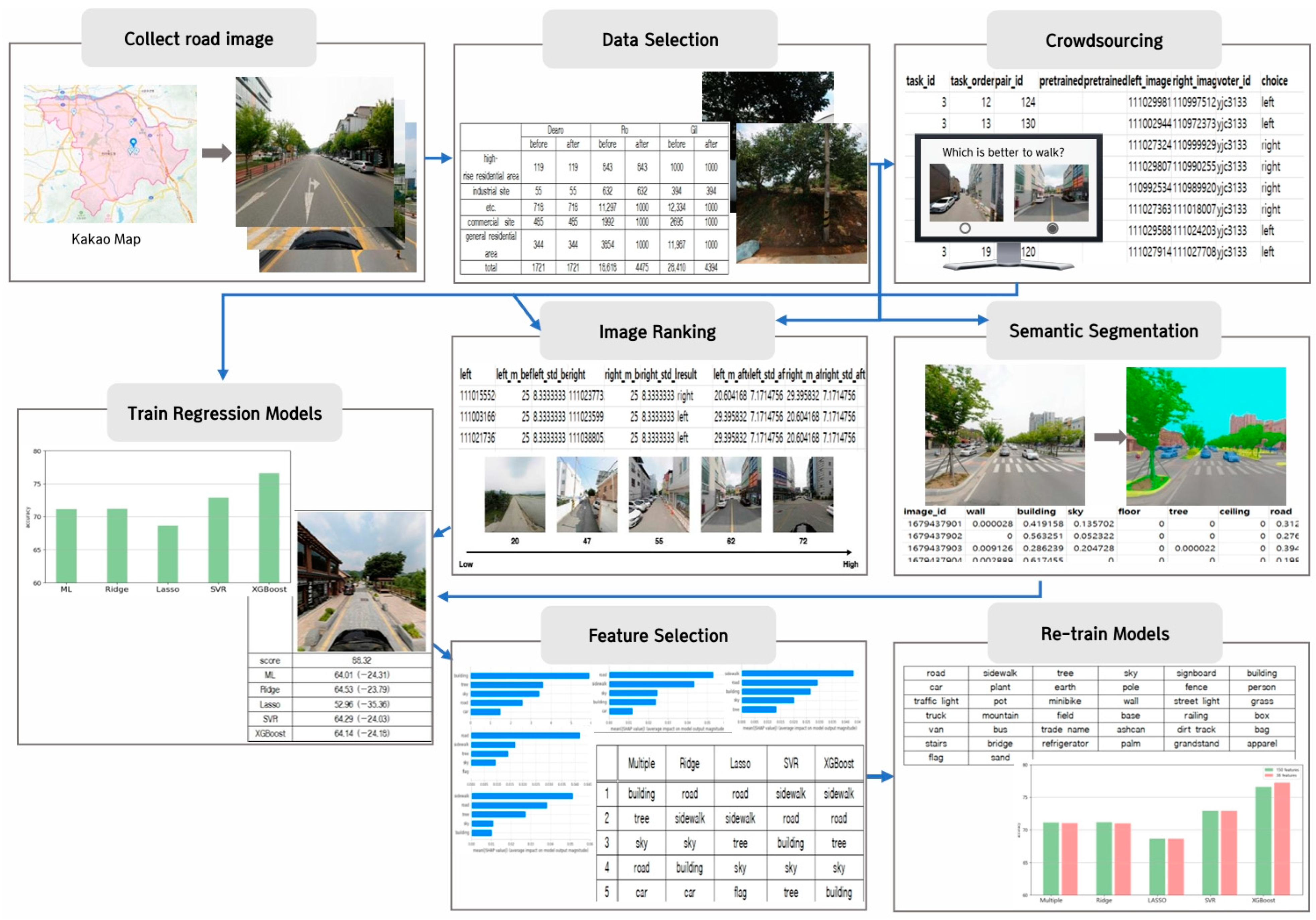

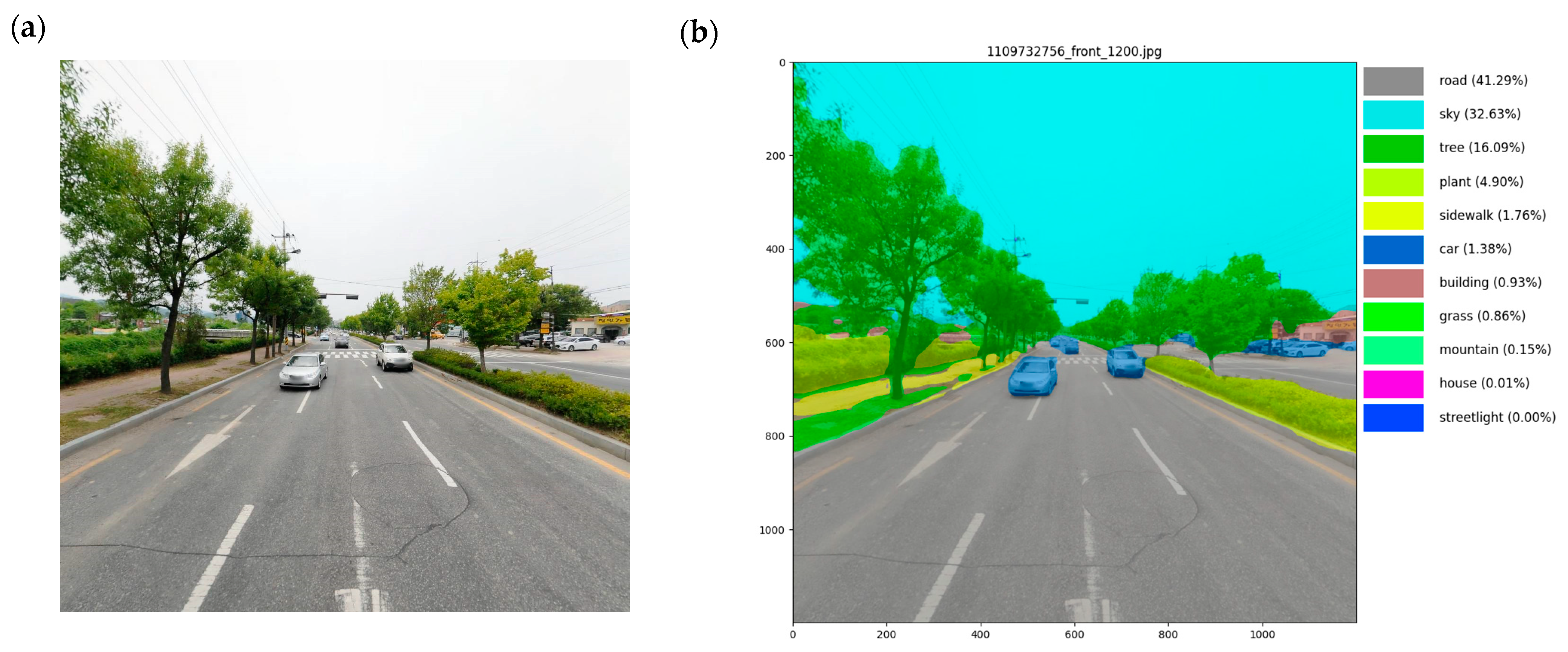
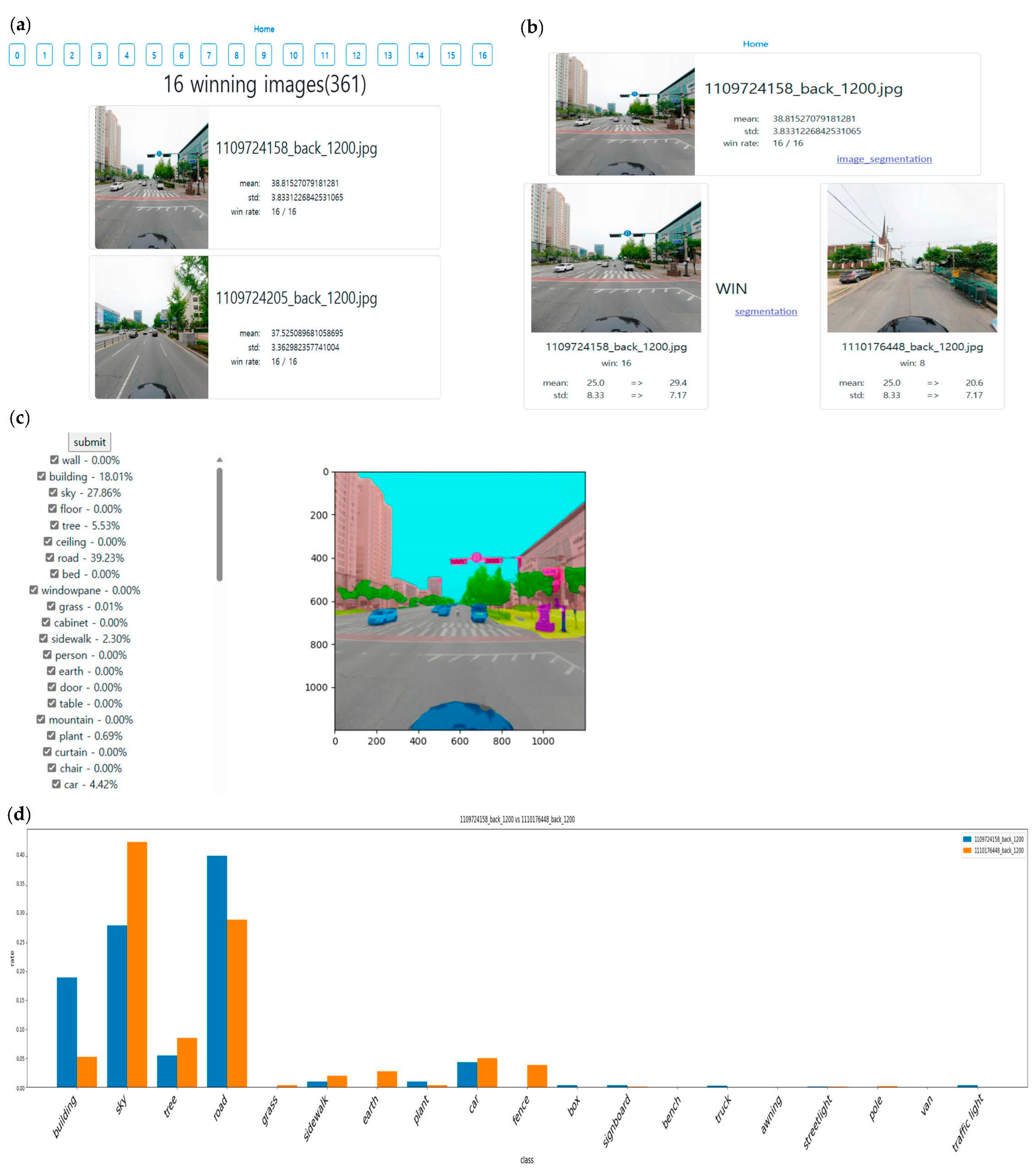
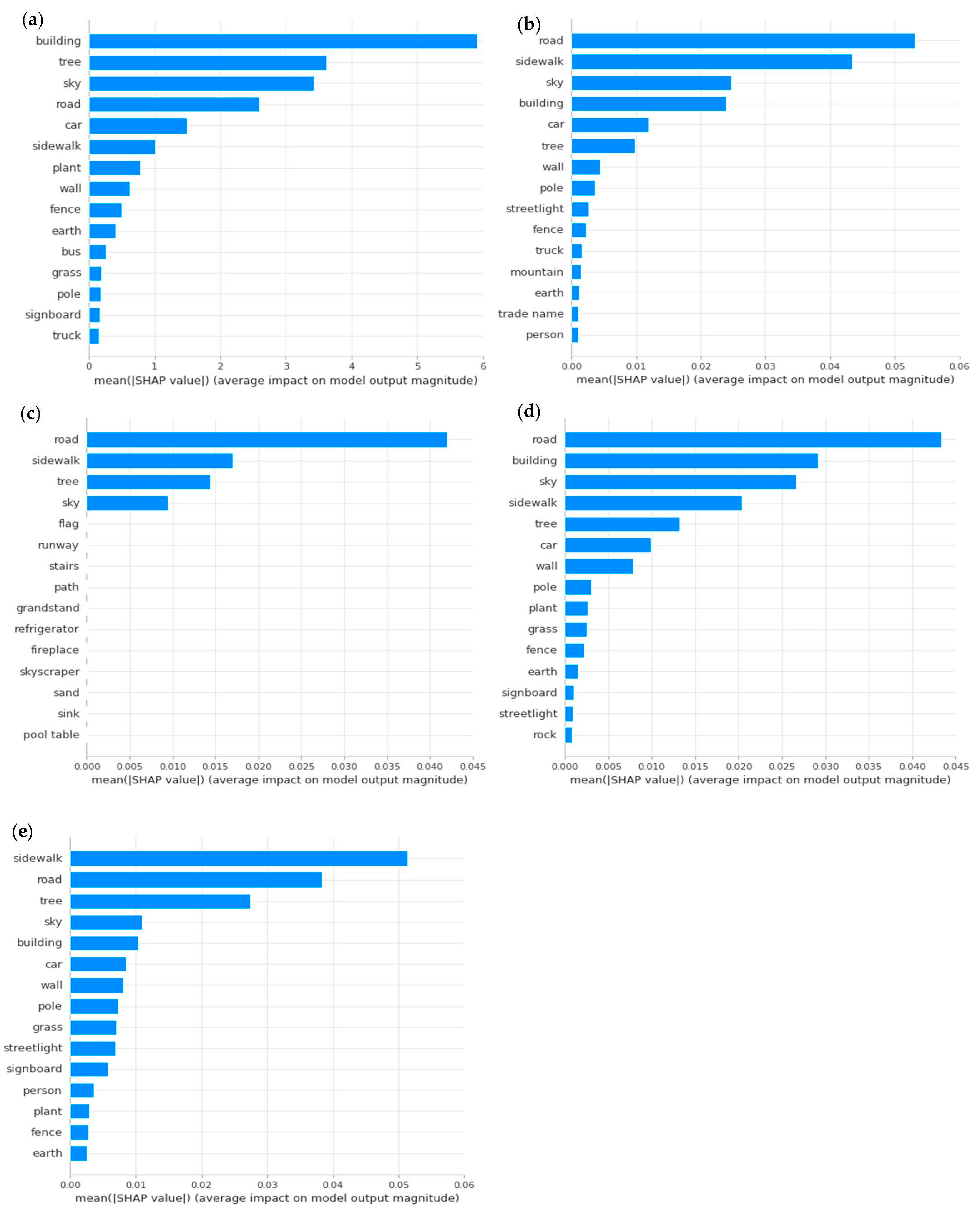
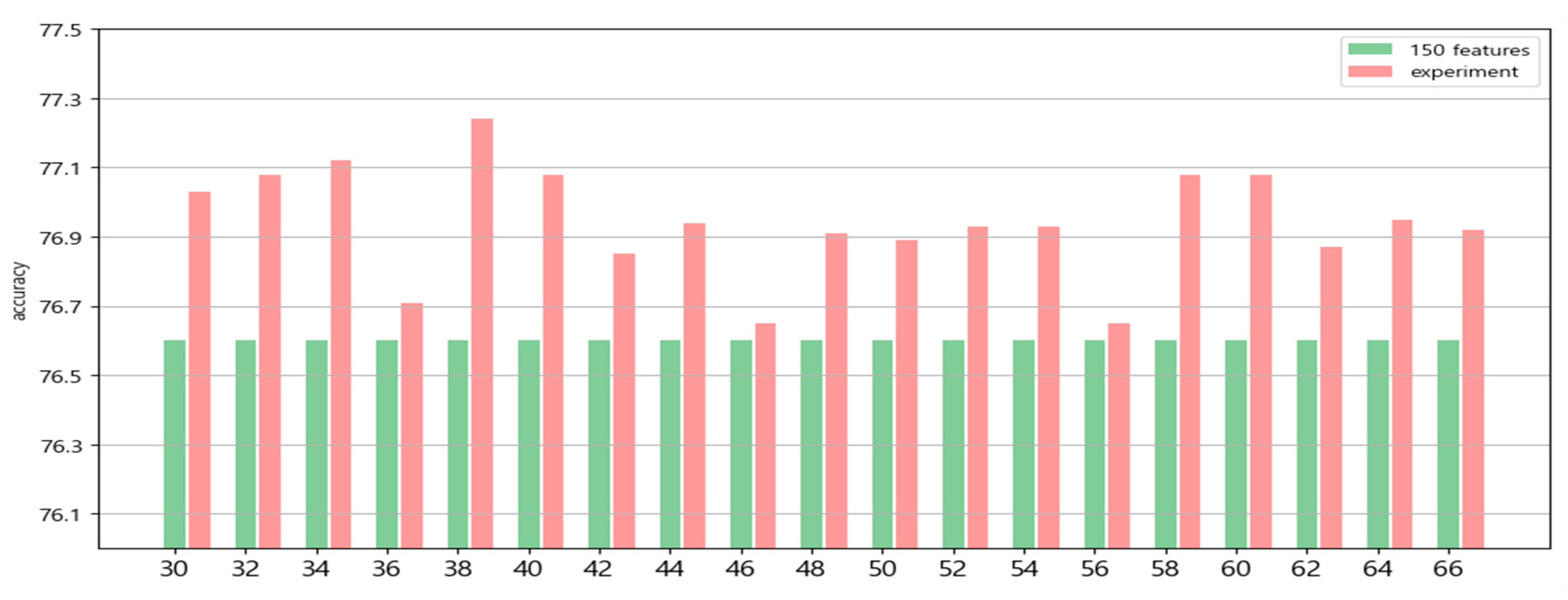
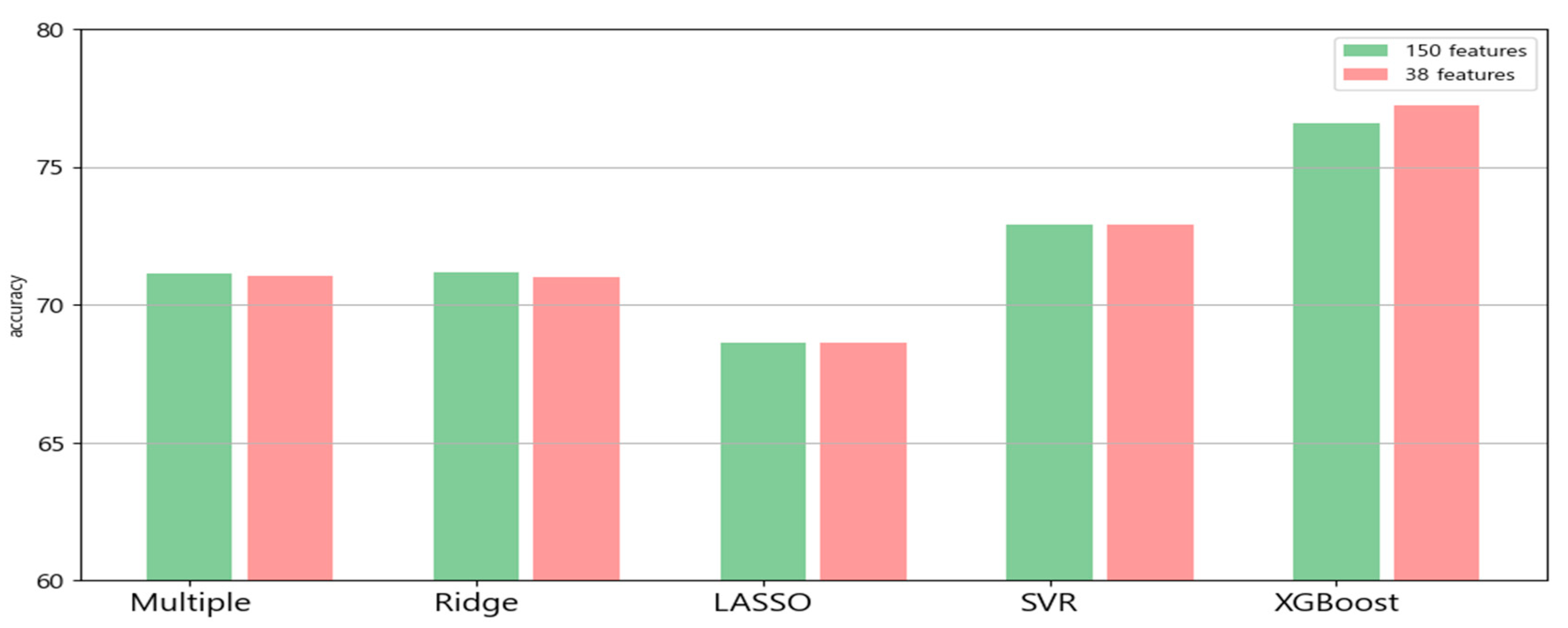
| Image Name | 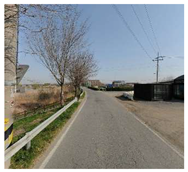 | 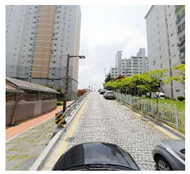 |
| Number of comparisons | 16 | 16 |
| Number of wins | 3 | 15 |
| Trueskill_mean | 17.226043 | 34.964508 |
| Trueskill_std | 2.8507967 | 3.0705123 |
| Left | Right | |
|---|---|---|
| Image name | 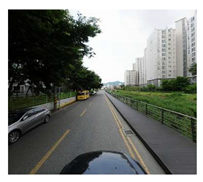 | 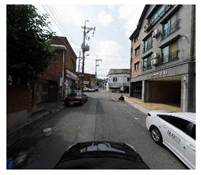 |
| Mean_before | 36.153447 | 23.979166 |
| Std_before | 3.4737805 | 2.7657728 |
| Result | left | |
| Mean_after | 36.362659 | 23.979166 |
| Std_after | 3.4737805 | 2.7657728 |
| Image name | 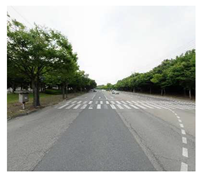 | 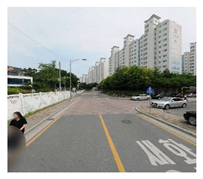 |
| Mean_before | 28.317252 | 30.239095 |
| Std_before | 3.5223532 | 3.4375636 |
| Result | right | |
| Mean_after | 27.181376 | 31.320974 |
| Std_after | 3.292593 | 3.2244403 |
| Number | 2 | 3 | 5 | 7 | 10 | 12 | 17 | 18 | 21 | 26 | 88 |
| Class | building | sky | tree | road | grass | sidewalk | mountain | plant | car | house | streetlight |
| Ratio (%) | 0.009258 | 0.326276 | 0.160924 | 0.41294 | 0.008617 | 0.017583 | 0.001495 | 0.048962 | 0.013838 | 0.000083 | 0.000024 |
| Model | MAE | MSE | RSME | R2 | Accuracy |
|---|---|---|---|---|---|
| Multiple | 1,893,901.1099 | 1.1760 | 108,443,675.1976 | −5.8665 | 71.15% |
| Ridge | 0.0804 | 0.0104 | 0.1024 | 0.4768 | 71.19% |
| LASSO | 0.0900 | 0.0127 | 0.1128 | 0.3650 | 68.64% |
| SVR | 0.0931 | 0.0087 | 0.0953 | 0.5635 | 72.91% |
| XGBoost | 0.0743 | 0.0089 | 0.0947 | 0.5522 | 76.60% |
| Dubey et al. [17] | 73.50% | ||||
| Kim et al. [25] | 75.01% |
| Image |  | 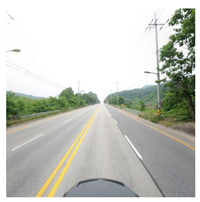 |
| Score | 88.32 | 49.47 |
| Multiple | 64.01 (−24.31) | 61.00 (+11.53) |
| Ridge | 64.53 (−23.79) | 60.85 (+11.38) |
| LASSO | 52.96 (−35.36) | 60.50 (+11.03) |
| SVR | 64.29 (−24.03) | 56.01 (+6.54) |
| XGBoost | 64.14 (−24.18) | 49.84 (−0.37) |
| Multiple | Ridge | LASSO | SVR | XGBoost | |
|---|---|---|---|---|---|
| 1 | building | road | road | sidewalk | road |
| 2 | tree | sidewalk | sidewalk | road | building |
| 3 | sky | sky | tree | building | sky |
| 4 | road | building | sky | sky | sidewalk |
| 5 | car | car | flag | tree | tree |
| 6 | sidewalk | tree | runway | car | car |
| 7 | plant | wall | stairs | pole | wall |
| 8 | wall | pole | path | earth | pole |
| 9 | fence | streetlight | grandstand | wall | plant |
| 10 | earth | fence | refrigerator | grass | grass |
| 11 | bus | truck | fireplace | signboard | fence |
| 12 | grass | mountain | skyscraper | field | earth |
| 13 | pole | earth | sand | ceiling | signboard |
| 14 | signboard | trade name | sink | person | streetlight |
| 15 | truck | person | pool table | base | rock |
| 16 | dirt track | ashcan | counter | plant | truck |
| 17 | trade name | traffic light | chest of drawers | box | railing |
| 18 | van | railing | signboard | van | bag |
| 19 | railing | dirt track | column | pot | ashcan |
| 20 | field | plant | box | house | traffic light |
| 21 | person | bag | case | traffic light | bus |
| 22 | traffic light | pot | stairway | bicycle | field |
| 23 | house | field | pillow | path | minibike |
| 24 | pot | awning | flower | water | box |
| 25 | streetlight | minibike | palm | bridge | van |
| 26 | base | signboard | stove | bench | sculpture |
| 27 | minibike | bridge | counter top | stairway | trade name |
| 28 | mountain | base | bench | windowpane | pot |
| 29 | ashcan | water | hill | apparel | awning |
| 30 | rock | ship | book | minibike | mountain |
| road | sidewalk | tree | sky | signboard | building |
| car | plant | earth | pole | fence | person |
| traffic light | pot | minibike | wall | streetlight | grass |
| truck | mountain | field | base | railing | box |
| van | bus | trade name | ashcan | dirt track | bag |
| stairway | path | awning | water | bridge | bench |
| sculpture | rock | flag | runway | stairs | grandstand |
| refrigerator | fireplace | skyscraper | sand | sink | pool table |
| ceiling | counter | chest of drawers | column | case | bicycle |
| house | pillow | flower | palm | stove | counter top |
| windowpane | hill | apparel | ship | book | door |
| road | sidewalk | tree | sky | signboard | building |
| car | plant | earth | pole | fence | person |
| traffic light | pot | minibike | wall | streetlight | grass |
| truck | mountain | field | base | railing | box |
| van | bus | trade name | ashcan | dirt track | bag |
| stairs | bridge | refrigerator | palm | grandstand | apparel |
| flag | sand |
Disclaimer/Publisher’s Note: The statements, opinions and data contained in all publications are solely those of the individual author(s) and contributor(s) and not of MDPI and/or the editor(s). MDPI and/or the editor(s) disclaim responsibility for any injury to people or property resulting from any ideas, methods, instructions or products referred to in the content. |
© 2024 by the authors. Licensee MDPI, Basel, Switzerland. This article is an open access article distributed under the terms and conditions of the Creative Commons Attribution (CC BY) license (https://creativecommons.org/licenses/by/4.0/).
Share and Cite
Hwang, J.; Nam, K.; Lee, C. Spatial Image-Based Walkability Evaluation Using Regression Model. Appl. Sci. 2024, 14, 4079. https://doi.org/10.3390/app14104079
Hwang J, Nam K, Lee C. Spatial Image-Based Walkability Evaluation Using Regression Model. Applied Sciences. 2024; 14(10):4079. https://doi.org/10.3390/app14104079
Chicago/Turabian StyleHwang, Jiyeon, Kwangwoo Nam, and Changwoo Lee. 2024. "Spatial Image-Based Walkability Evaluation Using Regression Model" Applied Sciences 14, no. 10: 4079. https://doi.org/10.3390/app14104079
APA StyleHwang, J., Nam, K., & Lee, C. (2024). Spatial Image-Based Walkability Evaluation Using Regression Model. Applied Sciences, 14(10), 4079. https://doi.org/10.3390/app14104079






